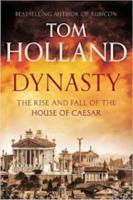
London (2015) h/b 482pp £25.00 (ISBN 9781408703373)
This book is the fruit of a tremendous blend of skills. The mastery of sources and the political insight of a Ronald Syme, the narrative drive and storytelling style of a Robert Graves, and the racy candour of a televisual bonkbuster like Rome or Spartacus: that combination packs quite a punch and H. is by now (after Rubicon, Persian Fire, Millennium and Shadow of the Sword) something of an old hand at the recreation of the ancient world in the printed word. Like Syme, H. stresses the power politics and has no false respect for ‘the crooks, the adventurers, the opportunists’ (as Louis Macneice called them [Autumn Journal ix]) who ran much of the Roman empire in the period from 27 BC to AD 69. H. is alert to their schemes and stratagems, using the primary sources with astonishing fluency and accuracy and presenting them as the mafiosi they undoubtedly were.
His book begins with the founding of Rome (the ‘Children of the Wolf’) before moving swiftly on to the late republic and the career of Julius Caesar. The second chapter (‘Back to the Future’) sees the focus move to Livia, the future wife of Augustus and the mother of the dynasty which gives the book its title. We are taken skilfully through the lives and the careers of Augustus (the ‘Padrone’) and his dynastic successors Tiberius, Caligula Claudius and Nero, and the forward thrust of the narrative is matched by the panoramic view H. also affords us of the wider Roman scene in areas such as religion, literature and sex.
There is much that is confusing and dubious in Roman history but H. manages to illuminate the shadows above all with his vivid eye for metaphor. The monuments which suddenly appeared just before Caesar crossed the Rubicon are described memorably thus (p. 86):
‘These rival developments, set as they were against the squalor and decay general in the rest of the city, had glittered like gold fillings amid a mouthful of bleeding gums.’
Those of us who have taught this period know how hard it can be for students to remember who is who (‘who? oh, that Agrippina’); H. is alive to this and overcomes it with vivid characterisation—Maecenas is seen as ‘perfumed and smooth’, Claudius had the reputation of being a ‘pliable dolt’, Tiberius was ‘notoriously stingy’ and so on—and he also gives us a wealth of illustrations and family-trees just where we need them. The style of the narrative prizes clarity above all else and this book (like its predecessors) will make a splendid audiobook in due course.
Much of H.’s material is familiar ground but quite a bit of it is not the usual fare served up to students in traditional schools and colleges. H. unearths a lot of the squalid and the sensational bits which our teachers somehow forgot to mention—did you know what Hostius Quadra (pp. 109-10) got up to with mirrors, or why Sporus was called Sporus? —or interesting vignettes such as Lucius Vitellius’ use of his beloved’s spittle mixed with honey as throat medicine (p.328). His motive is not mere prurience or tabloid sensationalism, but simply a continuation of Peter Wiseman’s insistence (Catullus and his World 1-14) that the Roman world was ‘a world not ours’. We should not see them as Victorian moralists but let them be what they were, warts, perversions and all.
Good historians always cite their sources and this can result in pages of exhaustive and exhausting footnotes: H. weaves the quotations into his narrative, letting the Romans themselves do much of the talking, and cites his sources in the footnotes at the end of the volume. Take this (p. 108) for an example of a remark on the sexual mores of the time backed up by a quotation and an apposite character-sketch:
‘ “How like a rustic, to get upset when your wife cheats on you.” So Ovid, a man with his finger on the pulse of high society, observed with practised smoothness.’
All the sources available to him are fair game—and this means that poetry is cited alongside prose histories, speeches, biographers,and that the contemporaries (such as Ovid and Horace) are cited alongside later authorities such as Suetonius and Plutarch. This does raise the obvious question about the relative merits of different categories of literature as reliable sources, but H. uses them with such judicious ease as part of a wholly convincing narrative that we rarely see the joins, and his highly convincing preface acknowledges the issue and justifies his stance. There is a very full bibliography to send us scurrying off for (even) more information on the areas covered, and the book is immaculately produced and proof-read.
This is almost certainly the most readable book on Roman history this year and it obviously deserves to be in every college and school library. You will certainly enjoy it and you will learn a lot from it, even if you think you know the story already, but caveat lector—it should also perhaps carry a 15 certificate.
Dr John Godwin—Moreton Hall School, Oswestry
